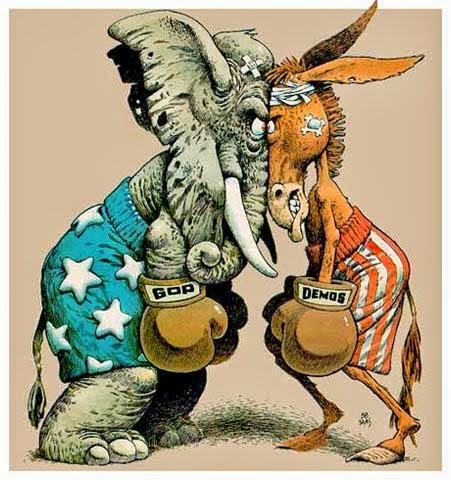After years dealing with financial crises on a last-minute basis, House Republicans and Senate Democrats couldn’t get organized enough to break the politically charged budget standoff over President Obama’s Affordable Care Act. Unable to organize an accord, lawmakers allowed the government to shut down. We know how this will effect government services, but how does the shutdown effect how the electorate sees the political parties themselves?
We use a highly validated emotional brand engagement assessment to measure B2B and B2C brands and we did the same thing for each of the major political parties. The assessment combines psychological inquiry and higher-order statistical analyses to “fuse” emotional and rational values, in this case those dealing with how the electorate sees their Ideal political party. Brand engagement assessments, whether for pizza or political parties, measures what consumers think – as opposed to what they say they think, and from a brand perspective provides an accurate read to how consumers, or in the case of political parties and their candidates, the electorate, will behave. We’ve used this model of engagement-ties-closely-to-behavior for every Presidential election since Bill Clinton ran in 1992 and the metrics have predicted the winner in every election – except in 2000, where George W. Bush beat Al Gore. You to be the judge about that one.
When it comes to Political Parties, four engagement drivers (and attendant expectation levels voters hold for each of those drivers) define the Ideal. The order of engagement drivers (and their associated expectations) vary in terms of what’s important to Democrats and Republicans, hence different party views and political brand affiliation. The drivers can be briefly described as follows:
Action:Does the party have a comprehensive, realistic, well-considered plan for solving the problems facing the country?
Compassion:Does the party care about all the people?
Perception:Does the party have a deep understanding of the problems facing the county?
Resolve:Does the party have the strength and leadership to guide the country?
Democrats see their Ideal Political Party as follows:
- Perception
- Resolve
- Compassion
- Action
Republicans view their Ideal Political Party this way:
- Resolve
- Perception
- Action
- Compassion
For Democrats, the driver with the highest expectations is “Compassion.” For Republicans it’s “Action.” Again, you be the judge about that.
We took this measure during the 2012 Presidential election, so it provides an up-to-date benchmark against which to measure how 253 registered Democrats and 267 registered Republicans (all non-government workers) rated how well their party upheld these values post-government shutdown. The Ideal is calculated to be 100%, and here’s how things currently stand.
Democratic Party Republican Party
2012 83% 77%
2013 76% 65%
If you do the math, The Democratic party saw their brand engagement strength decrease by 7%, the Republicans brand by a bit more, -12%. One brand engagement certainty we’ve seen play out over the years is something called the “Engagement Rule of Six,” which states that where brands are stronger than the competition, consumers are six times more likely to give them the benefit of the doubt in uncertain circumstances, which is a pretty fair description of a Federal government shutdown. So the usual finger pointing and political rhetoric notwithstanding, it’s likely the Democratic brand will come out a bit better than the Republican brand.
It was Will Rogers who noted, “I am not a member of any organized political party. I am a Democrat.” That was 81 years ago, and Democrat or Republican, the sentiment is worth taking to heart. Because whether a political party or a consumer brand, if you are so disorganized that you are unable to meet customer expectations, you always lose in the marketplace. Or, as is likely in this case, the voting booth.
Connect with Robert on LinkedIn.
Find out more about what makes customer loyalty happen and how Brand Keys metrics is able to predict future consumer behavior: brandkeys.com. Visit our YouTube channel to learn more about Brand Keys methodology, applications and case studies.
Share this:

